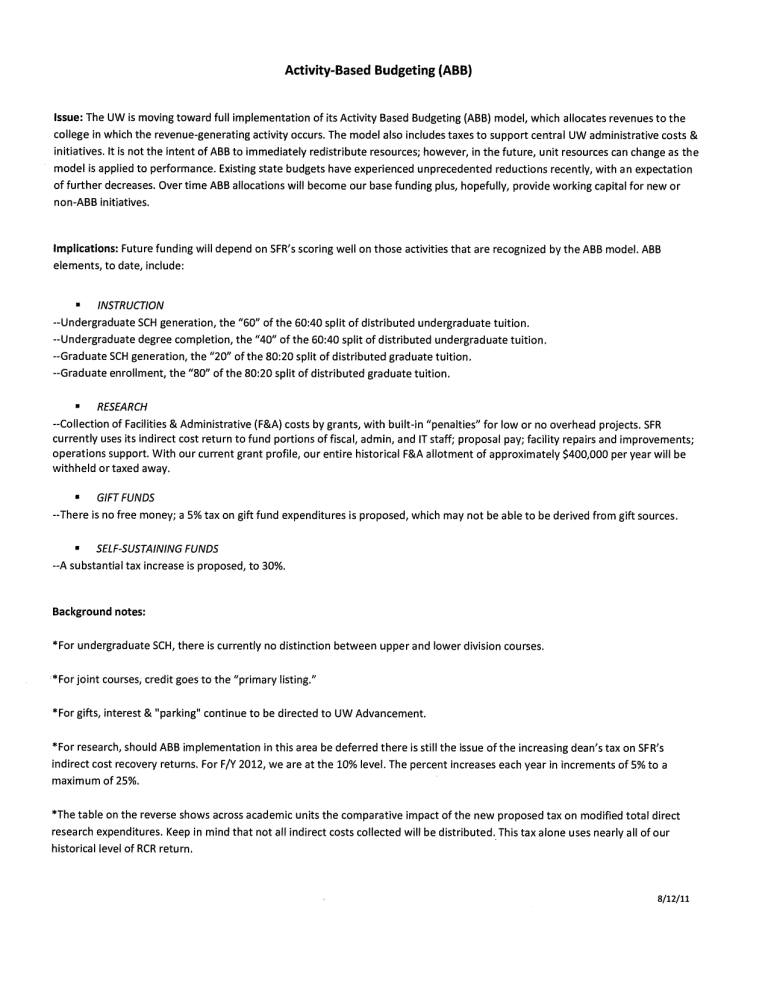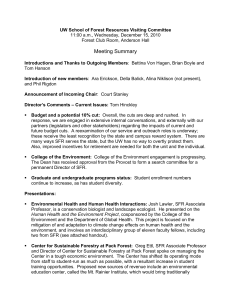Document 13447204

Transition Issue: Activity-Based Budgeting (ABB)
Description of the Issue and Implications:
See first two pages of this document.
Questions:
1. Do we continue to accept 0% or low overhead projects? Can other project elements compensate for low overhead? If so, what are those elements and how can they compensate? What actions can be taken to remedy long-standing unfavorable fiscal arrangements with agencies?
2. How can we continue our long history of teaching and research collaboration with other units and obtain the necessary “credit” under ABB?
3. Currently outreach activities have no way to produce ABB credit. Should outreach remain a priority of
SFR? If so, how can funding for those activities be produced or maintained? Are there opportunities to link to the ABB model?
Transition Issue: Faculty and Staff Capacity
Description of the Issue:
Staffing levels at SFR have been reduced, placing an increased burden on remaining staff for a variety of tasks and services, while shifting very few tasks from staff to faculty.
ABB rewards SCH and degrees (at different levels for undergraduate and graduate). Upcoming faculty retirements lead to uncertainties about whether SFR will be able to replace faculty, and how retirements will affect SFR’s teaching and research activities.
Implications:
Reductions in staff place an increasing burden on remaining staff to provide the same level of service to faculty and students. Added organizational layers have created inefficiencies in both time and workload for both faculty and staff.
The ABB system currently emphasizes and rewards growth in undergraduate majors, yet increasing
SCH and majors impacts staff and faculty support costs (advising, support, TAs, etc.). Uncertainties regarding faculty capacity for teaching include the fact that some smaller SCH courses are necessary for field experiences unique to SFR’s degree program. An important capacity implication relates to the numbers of students (undergraduate and graduate) that SFR can accommodate. Has SFR reached its limit, or is there current or future capacity (e.g., online learning) to continue growth at the undergraduate and graduate levels, and in what areas?
ABB rewards grants providing full indirect costs. Much of our grant portfolio has no or low indirect cost recovery, impacting our ability to support graduate students and fund administrative support costs.
Questions:
1. Are there any unfilled or unmet staff functions that would provide SFR with strategic advantages with regard to ABB metrics?
2. What is SFR’s capacity for what number of undergraduate majors and graduate students? Take into consideration historical and current teaching workload assignments, as well as research expectations, staff support, and lab space.
3. What strategies should SFR use in developing a new faculty portfolio analysis to identify future areas of focus for teaching and research?
Transition Issue: Students
Description of the issue:
Currently we have 300+ undergraduate students and 180 graduate students. Pressures from the ABB system, rising tuition costs, decreasing student funding, overall program capacity, and increasing diversity of students will require critical thinking, direction setting, and planning to realize high quality curricula and their cost-effective delivery.
Implications:
The ABB system is our new budgeting model, therefore, our financial future depends on how well we do on ABB metrics. Instructional metrics differ between graduate and undergraduate students 1 and may influence approaches to recruitment and curricular design.
Tuition is rising steeply for students, so there will be increased financial pressure to complete programs quickly and efficiently. At the same time, student funding has decreased, so the economic burden on students has increased. The ABB system rewards undergraduate degree completion, which also argues for curricular efficiencies.
Our field (especially in ESRM) and laboratory (in BSE) courses are feeling the pressure of increasing enrollments. These are high cost courses, but are valued highly by both students and faculty. At the graduate level, student support and advising loads vary by faculty and interest area.
Diversity is a core value of SFR and the UW, and to our credit, SFR’s student body has bcome more diverse over the last 10 years. As noted in a recent issue of the Wildlife Professional, “Unless we diversify our ranks and become more representative of the nation’s changing demographics, our profession and the resources we protect will not survive.”
Questions:
1. Given both our desire to deliver high quality curricula for undergraduate and graduate students and the ABB system of rewards, how should we determine enrollment numbers?
2. With increasing enrollments and the ABB system of rewards, how can we increase our instructional efficiency with respect to:
Field and laboratory courses
Time to degree completion
Use of online courses and programs
3. How do we recruit and retain a more diverse student body? If these students have different ways of knowing, how should we modify instructional deliveries to help retain them?
1. Undergraduate: 60% funding tied to SCH; 40% to degree completion
Graduate: 20% funding tied to SCH; 80% to enrollmen
Transition Issue: Advancement
Description of the issue:
Advancement has transitioned from SFR-based to CoENV-based. Staff support to SFR has been reduced from 2.5 full-time SFR Advancement staff to a CoENV-based staff that includes SFR support:
(1) shared major gift officer (with ESS) at the $100K+ level, (2) .5 FTE support, (3) some direct responsibility for UWBG, (4) responsibility for annual giving, and (5) event/alumni relations/ communications staff to assist with planning for “selected” unit events; facilitate alumni engagement; and “coordinate and assist” unit communications. Primary focus on major donors/prospects is a shift away from long-term relationship building with SFR alumni, annual givers, and outreach/tech transfer constituents. Alumni relations now managed at the CoENV level — a transition away from unit-based alumni relations. A new ABB tax (5%) may be imposed on spending from gift funds.
Implications:
The ABB budget model and decreased state support will require greater emphasis on other sources of funding, including philanthropy. SFR will need to ensure that CoENV-based advancement staff understands and facilitates SFR’s strategic plan goals and objectives. Although data show that bulk of
SFR’s gift support over the years has come from a few major individual and corporate donors, relationship building with a large alumni base, annual givers, and other constituents will need to continue. Keeping SFR’s “historic” alumni base engaged, while also engaging new graduates of SFR who may come to feel more connected with CoENV, will present challenges. Transition (via yet-to-be hired Constituent Relations/Events Manager) from unit coordination of newsletters and other communications to CoENV coordination is a possibility.
Questions:
Given decreased levels of CoENV staff supporting SFR Advancement; potential additional budget cuts impacting staffing across SFR; stronger focus by Advancement on major donors/prospects; and potential shift to College-level management of alumni relations/communications:
1. What priority should SFR, including its research and outreach centers, give to continued relationship building with SFR’s large alumni base, annual givers, and other constituents who may not be “major donors/prospects”? If high priority, how to accomplish? How to establish and prioritize goals related to this activity? How to track its success?
2. How can SFR ensure that Advancement staff working with SFR understand and facilitate SFR’s (and its research and outreach centers’) strategic plan goals and objectives related to fundraising?
Transition Issue: Reorganization of SFR's Research Centers
Description of the Issue:
This is an opportune time to give serious consideration to reorganizing our School’s research and outreach programs to seek better efficiency and effectiveness while complying with the new legislation defining the mission for the Institute of Forest Resources.
Coupled with the ongoing transition of leadership within SFR’s research centers, our shrinking state, federal and private research support, the negative impact of the ABB model on SFR’s indirect cost recovery and its ability to fund research administrative support services, and passage of SHB 1254 which redefines the Institute, it is appropriate to consider how our School is organized to effectively generate and disseminate new scientific information critical to the future prosperity of the state’s forest sector.
Implications:
As an umbrella organization, the Institute can leverage the ability of our research groups to more effectively compete for research funds, more efficiently manage funds obtained, more actively communicate to our many stakeholders, and be more proactive in conducting public and professional outreach programs.
Key Question:
1. How should the School reorganize its research enterprise in light of the newly defined Institute of
Forest Resources?"
To provide guidance in responding to this question, any proposed new organizational structure must address the following criteria. Relative to our existing structure, does the new organizational model: a) provide additional flexibility to address changing research issues and opportunities as they arise? b) promote internal efficiencies while simultaneously retaining the support of our external stakeholders who identify with a specific research program? c) increase our ability to respond to RFP's in a timely and effective manner? d) allow the School to effectively address the large turnover in center leadership?
Legislative Background:
SHB 1254 states (in part):
a) “The institute of forest resources must seek to provide a framework for identifying, prioritizing, funding, and conducting interdisciplinary research critical to the forest sector and the development of integrated, synthesized information and decision support tools that improve the understanding of complex forestry issues for stakeholders, policymakers, and other interested parties.
b) The director of the school of forest resources at the University of Washington shall coordinate the various cooperatives and centers within the school of forest resources to promote a holistic, efficient, and integrated approach that broadens the research and outreach programs and addresses issues facing the forest sector.
c) It is the intent of the legislature for the institute of forest resources to provide the structure and continuity needed by drawing contributions from the associated centers and cooperatives into a more consolidated, collaborative, interdisciplinary, and integrated process that is responsive to the critical issues confronting the forest sector.”
The term "forest sector" is to be interpreted broadly. The law says that:
“(1) The institute of forest resources shall pursue coordinated research and education related to the forest sector and its multiple components, including: (a) Forest conservation, restoration, sustainable management, and utilization; (b) The evaluation of the economic, ecological, and societal value of forest land in both the rural and urban environment; (c) The manufacture and marketing of forest products, including timber products, non-timber products, environmental services, and the provision of recreation and aesthetic values.
(2) The institute of forest resources must seek to provide a framework for identifying, prioritizing, funding, and conducting interdisciplinary research critical to the forest sector and the development of integrated, synthesized information and decision support tools that improve the understanding of complex forestry issues for stakeholders, policymakers, and other interested parties.
(3) In pursuit of these objectives, the institute of forest resources is authorized to cooperate, when cooperation advances the objectives listed in this section, with other entities, including but not limited to:
(a) Universities;
(b) State and federal agencies;
(c) Conservation and environmental organizations;
(d) Community and urban forestry organizations; and
(e) Domestic or foreign industrial and business institutions."
SFR Research Centers in the Institute
Precision Forestry Cooperative (includes RTI)
Stand Management Cooperative
Wind River – NEON
Center for International Trade
Center for Sustainable Forestry at Pack Forest
Olympic Natural Resources Center
UW Botanic Gardens
NW Environmental Forum


